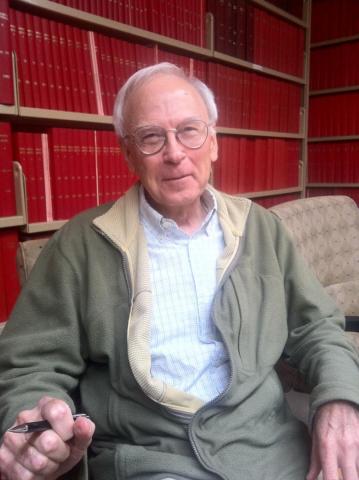
On Wednesday, November 19th, the LHCb collaboration at CERN's Large Hadron Collider (LHC) announced the discovery of two new particles in the baryon family. The particles, known as the Xi_b'- and Xi_b*-, were predicted to exist by the quark model but had never been seen before.
Randy Lewis, York University, and Richard Woloshyn (photographed on right), TRIUMF, submitted a paper together in 2009, “Bottom baryons from a dynamical lattice QCD simulation,” in which the masses of Xi_b’- and Xi_b* were predicted. This paper, among the eight theoretical papers cited in the LHCb collaboration report submitted to the Physical Review Letters, offered the LHCb researchers a light in the path of discovery.
“Theoretical and experimental physics complement each other in an important way,” said Petr Navratil, Head of Theory Department at TRIUMF. “Richard's work illustrates how theoretical predictions motivate experimental efforts. Experimental results then provide feedback to improve the theoretical understanding.”
The new particles are baryons made from three quarks bound together by the strong force. The types of quarks are different, though: the new Xib particles both contain one beauty (b), one strange (s), and one down (d) quark. Thanks to the heavyweight b quarks, the baryons are more than six times as massive as the proton. But the particles are more than just the sum of their parts: their mass also depends on how they are configured. Each of the quarks has an attribute called "spin". In the Xi_b'- state, the spins of the two lighter quarks point in opposite directions, whereas in the Xi_b*- state they are aligned. This difference makes the Xi_b*- a little heavier.
"Nature was kind and gave us two particles for the price of one," said Matthew Charles of the CNRS's LPNHE laboratory at Paris VI University.
"The Xi_b'- is very close in mass to the sum of its decay products: if it had been just a little lighter, we wouldn't have seen it at all using the decay signature that we were looking for."
"This is a very exciting result. Thanks to LHCb's excellent hadron identification, which is unique among the LHC experiments, we were able to separate a very clean and strong signal from the background," said Steven Blusk from Syracuse University in New York. "It demonstrates once again the sensitivity and how precise the LHCb detector is."
“I am happy that LHCb cites our work and that it appears on the broader stage, ” said Richard Woloshyn, “It shows the work we do here at TRIUMF and in Canada is important.”
As well as the masses of these particles, the LHCb team studied their relative production rates, their widths - a measure of how unstable they are - and other details of their decays. The results match up with predictions based on the theory of Quantum Chromodynamics (QCD). QCD is part of the Standard Model of particle physics, the theory that describes the fundamental particles of matter, how they interact and the forces between them.
“Our approach was based directly on QCD. These results give us confidence and show that the theory is adequate to deal with any measurement and to predict the outcomes of experiments,” said Richard.
“This success is a reminder of TRIUMF's leadership role in theoretical physics. Richard has been using the computational method called lattice QCD to make important contributions for many years, and I am one of several people who learned lattice QCD by spending time at TRIUMF with Richard,” said Randy Lewis.
Richard admits that when he first saw the InterActions news release he did not expect it to be related to one of his theoretical ‘discoveries’ and set it aside to read later. It wasn’t until he saw the CBC headline, “New subatomic particles predicted by Canadians found at CERN” that he knew of his part in the discovery.
Richard Woloshyn photographed above in the TRIUMF Library.
Links:
- Richard Woloshyn and Randy Lewis’ paper on Arxiv
- LHCb paper on Arxiv
- "New subatomic particles predicted by Canadians found at CERN" (CBC)
- "New subatomic particles fulfill Canadian physicists’ prediction" (Globe and Mail)
- InterActions Press Release
–Prepared by Kyla Shauer with content from the InterActions Press Release
